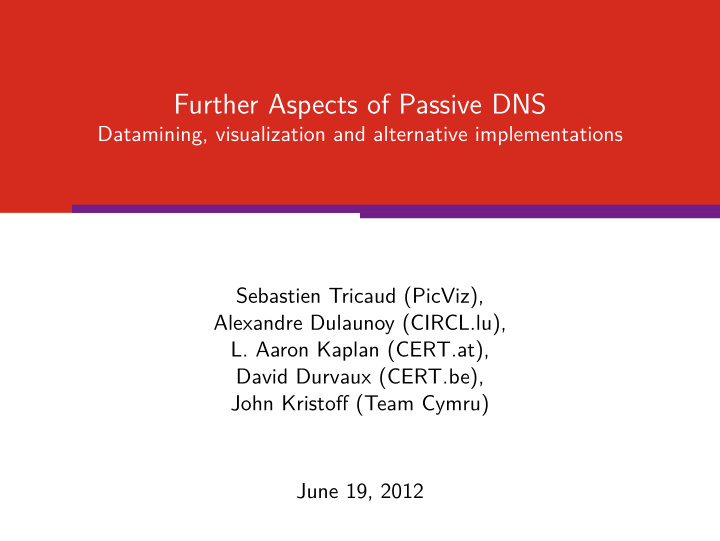



Further Aspects of Passive DNS Datamining, visualization and alternative implementations Sebastien Tricaud (PicViz), Alexandre Dulaunoy (CIRCL.lu), L. Aaron Kaplan (CERT.at), David Durvaux (CERT.be), John Kristoff (Team Cymru) June 19, 2012
Disclaimer • Passive DNS is a technique to collect only valid answers from authoritative or caching nameservers • By its design, privacy is preserved (e.g. no source IP addresses from resolvers are captured 1 ) • DNS data collected is only publicly known DNS data • The research is done in the sole purpose to detect malicious IP/domains or content to better protect users • Passive DNS implementations are subject to local rules 1 Except if an application abuses DNS answers to track back their users. 2 of 26
“Passive DNS is to DNS ops as NetFlow is to net ops.” John Kristoff 3 of 26
Passive DNS - how it works 4 of 26
What’s the purpose? Some examples... 5 of 26
Detection of shared compromised web hosting - the enisa.eu case • Regularly malicious links are posted on compromised systems • What are the other services or domains hosted on the same A/AAAA record? • What happens to ”infected” redirect (because the web hosting server is infected)? • How Passive DNS can help? 6 of 26
EG (Egypt being offline) • Discover non resolvable domains using nameserver in Egypt • Interesting discovery randomstring .medicpills.ru ( → less spam?) • BIT.LY case is similar (when Libya was offline) • Passive DNS helps to find interdependecies among services 7 of 26
Malware infection • History of a domain name in conjunction with Netflow records • Find shorted lived domain names • Get back the A/AAAA records • and find infected PCs in your Netflow. • Quick win! 8 of 26
Passive DNS implementations • CERT.lv passive dns • BFK (F. Weimer a ) passive dns • ISC DNSDB a • CIRCL pdns-toolkit b • The University of • CERT.at passive dns c Auckland DNS History • CERT.ee passive dns Database Project (DHDB) a Presented at FIRST 2005 • Team Cymru passive dns b github.com/adulau/pdns-toolkit/ c access upon request a https://dnsdb.isc.org/ 9 of 26
Passive DNS design comparison - an ecosystem CIRCL pdns-toolkit CERT.at passive dns datastore Redis PostgreSQL + memcached storage memory hybrid exhaustive - + space efficient ++ + input pcap, dnscap output nmsg open source yes ask 10 of 26
Some statistics from the CERT.at Passive DNS. . . 11 of 26
Storing Passive DNS - CIRCL.lu perspective • Implementing the storage of a Passive DNS can be challenging • Starting from standard RDBMS and then moved to a key-value store • We learned to hate 2 hard disk drive and to love random access memory • Loving memory is great especially when it’s now cheap and addressable in 64bits 2 exception → only used for data store snapshot 12 of 26
Passive DNS + Ranked domains - Where visualization can help • Now, we have 50 millions lines of ranked hostname... ... www.stopacta.info. www.vista-care.com. breadworld.com. o-o.resolver.A.B.C.D.5xevqnwsds5zdq34.metricz.\ l.google.com. www.thechinagarden.com. smtp10.dti.ne.jp. ... 13 of 26
Why visualization? • Understand big data • Find stuff we cannot guess 14 of 26
Choosing Parallel Coordinates • Display as much dimensions wanted (yes, as many ) • Display as much data wanted (I mean it!) 15 of 26
Interesting patterns 16 of 26
Picvizing a CIRCL passive DNS dataset 17 of 26
Picviz with subdomains split 18 of 26
Reward: highest is youtube 19 of 26
Subdomain entropy Only one sub-domain has an entropy 3 > 4.8 3 Shannon entropy 20 of 26
Subdomain entropy Only one sub-domain has an entropy 4 > 4.8 4 Shannon entropy 21 of 26
Scatter plot - finding outliers 22 of 26
Scatter plot - finding outliers - covert channel? 030066363663643937306531[..].36393764313333653763.lbl8.mailshell.net t10000.u1318235395163.s203679668[..]-1329.zv6lit-null.zrdtd-1311.zr6td- null.results.potaroo.net 03003064303831663965386[..].64306561343837346533.lbl8.mailshell.net 23 of 26
Searching for Zeus Using the broad Polish CERT regex [a-z0-9]{32,48}\.(ru|com|biz|info|org|net) • We get some cool domains: ◦ cg79wo20kl92doowfn01oqpo9mdieowv5tyj.com ◦ eef795a4eddaf1e7bd79212acc9dde16.net • but more important we got a visualization profile to find outliers not matching the regexp 24 of 26
Conclusion • Passive DNS is an infinite source of security data mining • A team of passive DNS is at your services, contact us! • (adequate) Visualization is an appropriate way to discover unknown malicious or suspicious services • This finally helps CSIRTs to act earlier on the incidents • Common output format for different implementations (work in progress) 25 of 26
Q&A • alexandre.dulaunoy@circl.lu • sebastien@honeynet.org • kaplan@cert.at • david.durvaux@cert.be • jtk@cymru.com 26 of 26
Recommend
More recommend